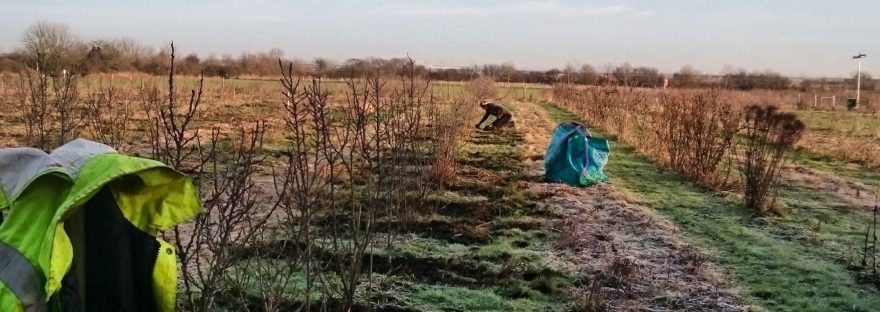Autumn has peeled away the last vestiges of a long hot summer. Daytime temperatures have dropped almost 10 deg C. Overcast skies are delivering a little rain. It being October field work on the sea buckthorn changes direction away and looks towards preparing for the 2017 crop.
With each delivery of new plants from Siberia I have held a few back. These are potted and kept to be replacements for any plants that die. With soil temperatures still high, day time temperatures at 10-15 deg, and rain is starting to provide natural moisture again, this seems a good time to plant out some of these plants.
The north end of the main orchard was not planted up with the first plantings in 2011. It is a very dry area with heavy clay. In 2014 I planted it with sea buckthorn varieties Jessel, Inya and Elizaveta. The results have been predicatable. Of the 180 Jessel plants there are 50 that need replacing. It is disappointing but this was always going to be a struggle for young plants. I have replacements but on trying to plant them out I found the ground absolutely solid. How the plants have established I am not sure. As I do not irrigate I pay a penalty in terms of losses of young plants and longer establishment time. Those that have made it have searched out deep water to get them through this very dry summer. Deep roots will stand them in good stead if climate change is going to deliver long hot summers in the future.
With the ground being so hard, planting out has to be shelved. The hard ground does allow for vehicle access without soil compaction so all these young plants are now weeded, pruned of dead wood and given a good dose of compost. The only way of improving thee soil and making it lighter will be introducing organic matter into it and hopefully an autumn and spring top dressing over the next three years will ease the clay into becoming more friable and produce healthy plants.
Soil health is now a key interest in UK agriculture. Nurturing it and feeding the myriad of micro-organisms that make up the soil can have huge benefits. A healthy soil has a greater capacity to hold water and nutrients. It should contain a balance of bugs that can control others that we would see as the root cause of disease. Its structure should allow plant roots to grow through it with ease, accessing plant nutrients and water and allowing more energy to go into crop yield and quality.
Climate change is an issue for us all. Turning the soil produces a release of CO2. Traditionally fields have been ploughed burying weeds, organic matter from the old crop and weed seeds. This organic matter helps feed the microbes that live in the soil. In places like the US, if this process is done in dry seasons, the soil dries out and can blow away. Soil loss becomes a real issue. It can be lost to wind, but also in the UK to extreme rain downpours with it being washed off the fields. In China this has become a real issue with up to 40% – 3,500,000 square kilometres of land affected. Poor soils equate to poor crop yields. It threatens the livelihood of 100 million people directly but indirectly poor crop yields impacts on food supplies for a growing population. Ironically, sea buckthorn is being used in dry areas to reverse this as it can establish in very poor soils. Its roots bind the soil and its leaves provide new organic matter to feed it.
In the UK and US ploughing is giving way to less intrusive deep soil cultivation or even no cultivation at all. This is called no-till cultivation. The process involves a machine that direct drills the seed into the ground with minimum disturbance of the top soil. The problem with this is that the organic matter from the old crop is not buried into the soil. It takes longer to break down and provide the essential nutrients for the soil bugs and the crop plant itself. To get around this a cover crop is grown to provide a green manure for the soil. This has to be either cultivated into the soil or killed with chemical sprays. This comes at both a financial and environmental cost.
I recently attended the Soil Association Farmer Innovation Day. These conferences are as much about networking as knowledge, but this one was particularly valuable. The presentations showed there is a mechanical way of tricking the cover crop into breaking down by crimping it with a series of rollers.
As our farm looks to a new world, post-Brexit government support for farming may well be significantly lower than EU pre- June 23rd payments. Subsidies in agriculture are an essential to the viability of small farms. All problems need solutions and planning to reduce their potential impact is important.
Registering the Devereux farm sea buckthorn with the Soil Association this summer is a three year process before it can become certified as organic. This was not a reaction to Brexit. It was a recognition that finally our method of growing sea buckthorn is delivering results from an organic process. Organic is only viable if there are processes that provide for crop growing method that delivers an economically sustainable crop yield for the farm. Growing sea buckthorn and using compost tea that is delivering both plant nutrient and health provides confidence that organic might be the way forward for the rest of Devereux farm in the future. This is a long process, but as almost half the farm is into conservation management, focusing the arable enterprise to compliment the rest of the farm will I hope bring biodiversity benefit as well as economic sustainability for the long term.

